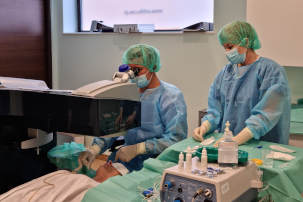
SBK LASIK and FemtoLASIK |
| 04.01.2025 |
 LASIK is one of the laser vision correction methods, i.e. one of the ways in which the cornea is prepared for the laser operation. Generally speaking, new generation LASIK treatments involve the creation of a corneal flap followed by the correction of a vision defect with an excimer laser. Depending on the technology used, the flap can be separated using a microkeratome or femtolaser.
LASIK is one of the laser vision correction methods, i.e. one of the ways in which the cornea is prepared for the laser operation. Generally speaking, new generation LASIK treatments involve the creation of a corneal flap followed by the correction of a vision defect with an excimer laser. Depending on the technology used, the flap can be separated using a microkeratome or femtolaser.
SBK LASIK is a more delicate version of the LASIK method. During the procedure, an ophthalmic surgeon precisely separates a thin sheet of epithelium (about 100 micrometers) using a microkeratome and an appropriately selected disposable head. This allows them to gain access to a deeper layer of the cornea. When the microkeratome head is operating, the patient can see darkness, which lasts approximately 3–5 seconds. The obtained flap is lifted and the cornea is then treated with the excimer laser to correct the refractive error.
Immediately after the excimer laser ablation is completed, and the cornea is appropriately reshaped, the flap is returned to its original position and smoothed into place, where it reattaches to the corneal surface spontaneously, without causing any pain immediately after the procedure. The symptoms most often reported by patients are excessive tearing and a feeling of sand under the eyelids, which may last from several hours to 2–3 days.
In the FemtoLASIK method method, the flap is created using a femtosecond laser. In order for it to work predictably and precisely, it must be attached to the surface of the eye during the so-called docking. This requires some time and care. The laser pulses cause CO2 and H2O bubbles to be created.
This is when the photodisruption process takes place – collagen fibres are torn apart. When this process occurs, the patient’s vision becomes blurred. Depending on the laser, this may take even up to 60 seconds. It needs to be mentioned that the femtosecond laser is used only at the stage of producing the corneal flap. Once the cornea is prepared, it is necessary to change the devices so the patient is moved under the arm of the excimer laser to correct the vision defect.
As in the case of the SBK LASIK method, after the laser treatment is finished, the corneal flap is placed back in its place.
| SBK LASIK | FemtoLASIK |
| regular and smooth corneal flap | irregular corneal flap – micro-irregularities may lead to so-called rainbow glare |
| procedure possible in patients with thinner cornea | impossible to perform if the cornea is too thin |
| quick procedure, not requiring changing the laser devices | longer procedure – necessity to switch laser devices |
| no temporary blurriness under the flap during the procedure – shorter procedure time for the patient | temporary blurriness under the flap due to the development of CO2 and H2O bubbles (so-called opaque bubble layer in even 20% of the procedures), which requires additional surgeon’s intervention and significantly prolongs the duration of the procedure |
From the patient’s point of view, it is impossible to determine which type of LASIK procedure is better. Also in clinical trials comparing both methods, there no clear favourite – the effectiveness and safety of both methods are very similar. Nevertheless, the success of the procedure still depends mainly on the knowledge and skills of the ophthalmic surgeon and on the proper healing process. The recovery period will be similar in both cases. Regardless of the correction method, the cornea heals within 30 days and during this period it is necessary to follow specific recommendations and restrictions.